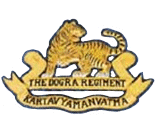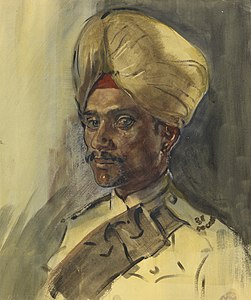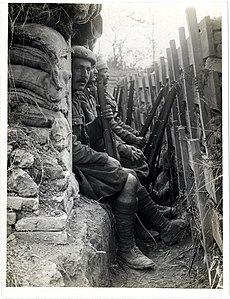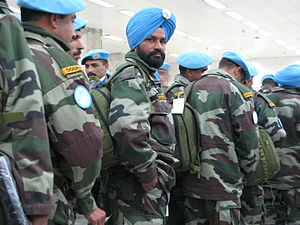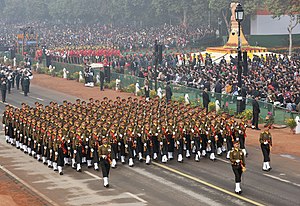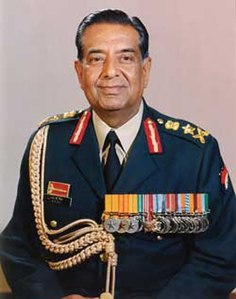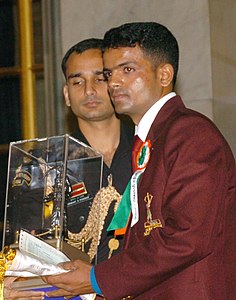
The Jammu and Kashmir Rifles is an infantry regiment of the Indian Army. Its origins lay in the Jammu and Kashmir State Forces of the princely state of Jammu and Kashmir. After the accession of the state to the Indian Union in October 1947, the State Forces came under the command of the Indian Army. They remained in the original form until 1956 when Jammu and Kashmir Constituent Assembly effectively ratified the state's accession to India. Then the State Forces became the Jammu and Kashmir Regiment of the Indian Army. In 1963, the designation was changed to Jammu and Kashmir Rifles. After the conversion, the Ladakh Scouts came under the aegis of the Regiment, where it remained until raised as a separate Regiment in 2002.

The Parachute Regiment is an airborne and special forces regiment of the Indian Army. It was raised in 1945 as part of the British Indian Army but was disbanded after World War II and was re-raised in 1952 as part of the Indian Army. Currently it consists of fifteen Special Forces, two Territorial Army and one Rashtriya Rifles battalions.

The Kumaon Regiment is one of the oldest infantry regiments of the Indian Army. The regiment traces its origins to the 18th century and has fought in every major campaign of the British Indian Army and the Indian Army, including the two world wars, and is one of the highest decorated regiments of the Indian Army.

The Punjab Regiment is the second oldest regiment still in service in the Indian Army, and is the most senior regional infantry regiment. It was formed from the 2nd Punjab Regiment of the British Indian Army in 1947 and has taken part in various battles and wars since, winning numerous honours for the same.
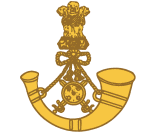
The Maratha Light Infantry is a light infantry regiment of the Indian Army. It traces its lineage to the Bombay Sepoys, raised in 1768, making it the most senior light infantry regiment in the Indian Army.

The Rashtriya Rifles is a counter-terrorism force in India, formed in 1990, to specifically serve in the Jammu and Kashmir region. They also maintain public order by drawing powers from the Armed Forces Special Powers Act, 1990 (AFSPA). The RR was raised by the Indian Army by reconstituting two corps. Its personnel are provided by the Indian Army on deputation. The RR is commanded by an Additional Director General of Rashtriya Rifles.
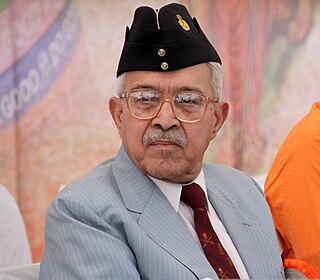
Lieutenant General Mohammad Ahmed Zaki is a former general officer of the Indian Army.

The Garhwal Rifles, formerly known as the Royal Garhwal Rifles, are an infantry regiment of the Indian Army. It was originally raised in 1887 as the 39th (Garhwal) Regiment of the Bengal Army. It then became part of the British Indian Army, and after the Independence of India, it was incorporated into the Indian Army.

The 9th Gorkha Rifles is a Gorkha infantry regiment of the Indian Army and, previously, the British Army. The regiment was initially formed by the British in 1817, and was one of the Gurkha regiments transferred to the Indian Army after independence as part of the tripartite agreement in 1947. This Gorkha regiment mainly recruits soldiers who come from Nepal's Gorkhali warrior community i.e. the Khas/Chhetri and Thakuri clans. Domiciled Indian Gorkhas are also recruited, and they form about 20 percent of the regiment's total strength. The 9 Gorkha Rifles is one of the seven Gorkha regiments of the Indian Army. The other regiments are 1 GR, 3 GR, 4 GR, 5 GR (FF), 8 GR and 11 GR.
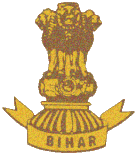
The Bihar Regiment is an Indian Army infantry regiment. It traces its origins back to the British Indian Army. The Bihar Regiment was formed in 1941 by regularising the 11th (Territorial) Battalion, the 19th Hyderabad Regiment, and raising new battalions. The Bihar Regimental Centre (BRC) is located at Danapur Cantonment, Patna, the second oldest cantonment of India. INS Vikramaditya, the Indian Navy's largest ship and one of its two aircraft carriers is affiliated to the Bihar Regiment, Indian Army's highly decorated and battle-hardened unit.
The 15th Indian Division was an infantry division of the British Indian Army that saw active service in the First World War. It served in the Mesopotamian Campaign on the Euphrates Front throughout its existence. It did not serve in the Second World War, but was reformed at Dehradun in 1964 as part of the post-independence Indian Army.
The 48th Infantry Brigade, was raised as the 48 Indian Infantry Brigade, in October 1941, at Secunderabad, India. After an initial tenure with 19th Indian Infantry Division, it was transferred to the 17th Indian Infantry Division. In World War II it participated in the Burma campaign and in April 1942 was attached to 1st Burma Division. After the war the brigade returned to India as an independent brigade, and was located at Dhond in August 1947. After India gained Independence in 1947, 48 Indian Infantry Brigade was re-designated as 48 Infantry Brigade. Since then 48 infantry brigade has seen action Goa in 1961, as part of 17 Infantry Division; in the 1962 War in Kameng Frontier Division, Arunachal Pradesh, as part of 4th Infantry Division; and in the 1971 war, as part of 7th Infantry Division. Since the 1970s, 48 Infantry Brigade has been located in Ferozpur, Punjab, as part of 7 Infantry Division.

Lieutenant General Balwant Singh Negi, PVSM, UYSM, YSM, SM, VSM & Bar is a former General Officer-Commanding-in-Chief (GOC-in-C), Central Command of the Indian Army who served in office from 1 December 2015 till 30 September 2018. He assumed the post after Lt General Rajan Bakshi retired and was succeeded by Lt General Abhay Krishna.
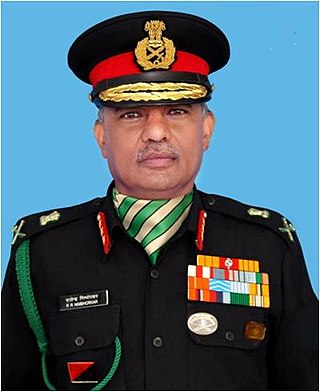
Lieutenant General Rajendra Ramrao Nimbhorkar, PVSM, UYSM, AVSM, SM**, VSM is a former officer of the Indian Army who served as the Master General Ordnance (MGO). He assumed office on 9 August 2017 after Lieutenant General Ravi Thodge retired. He was part of one of the strike corp which was responsible for carrying out three strikes inside POK in Surgical Strikes held in 2016 by the Indian Army to clean out all the Pakistani Terrorists Camps. As surgical strikes were carried out very secretly to maintain surprise, so very few people knew of them, one of those involved was Lt. Gen. Nimbhorkar.

Lieutenant General Satinder Kumar Saini, PVSM, AVSM, YSM, VSM, ADC was the 41st Vice Chief of the Army Staff of the Indian Army and assumed the office on 25 January 2020. He previously served as General Officer Commanding in Chief (GOC-in-C) Southern Command.

Lieutenant General (Dr) Jaiveer Singh Negi PVSM, AVSM, YSM, VSM** is a retired General Officer who has served as the 49th Commandant of the Indian Military Academy. He took over from Lieutenant General Sanjay Kumar Jha, PVSM, AVSM, YSM, SM, on 1 February 2020. Prior to his appointment as Commandant of the Indian Military Academy, he was the Deputy Commander-in-Chief of Strategic Forces Command

Lieutenant General Harinder Singh PVSM, AVSM, YSM, SM, VSM, is a retired General Officer of the Indian Army. He retired from Indian Army after serving as commandant of Indian Military Academy in his last appointment. Previously, he was the Commander of XIV Corps from October 2019 to October 2020, succeeding Lt Gen Yogesh Kumar Joshi, PVSM, UYSM, AVSM, VrC, SM, ADC.
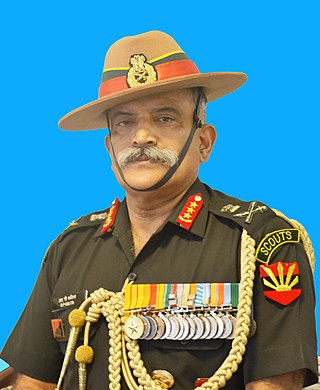
Lieutenant General Rana Pratap Kalita, PVSM, UYSM, AVSM, SM, VSM is a former general officer in the Indian Army. He served as the General Officer Commanding-in-Chief (GOC-in-C) of the Indian Army's Eastern Command. He previously commanded the III Corps at Dimapur.
195 Medium Regiment (Banwat) is part of the Regiment of Artillery of the Indian Army.
101 Field Regiment is part of the Regiment of Artillery of the Indian Army.
